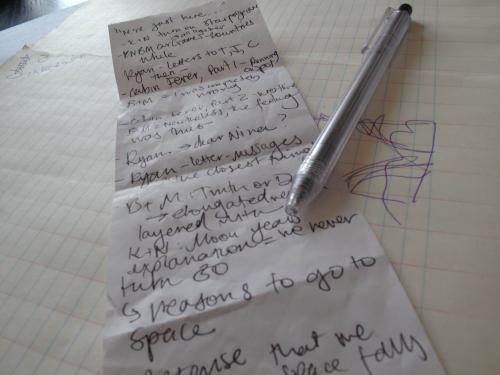She Talks to Beethoven is one of Adrienne Kennedy’s Suzanne Alexander plays, in this case centering on Alexander in Ghana in 1961, shortly after the country’s independence, as she convalesces from a wound and awaits news of her husband, David, a “revolutionary poet,” professor, and possible renegade from political assassins, who may already have been killed. In a sense, the play pits Alexander’s tension with the tensions of Beethoven’s Fidelio, in which a woman rescues her husband from a political prison. In other words, Kennedy considers the role of art as consolation and inspiration during difficult times. The play also delves into the creative process as Alexander and her husband, who wrote together at times, had quarreled over a play she was writing on Beethoven, as, David felt, Suzanne viewed the great composer in too romantic a fashion. Rather than simply paralleling Alexander’s predicament with the plot of Fidelio, Kennedy puts Alexander in dialogue with Beethoven himself, who is undergoing great stress in his own life while writing Fidelio, due to his health problems, established deafness, difficulties with his nephew to whom he acts as guardian, and the creative struggle of writing his sole opera, to say nothing of the invading French army led by Napoleon. What Kennedy creates, in this dialogue and overlap, is a sense of how immersion in Beethoven’s difficulties helps Alexander to deal with hers, but, because Beethoven is present to her, there is also the sense that Alexander becomes a confidante, almost a collaborator with the composer.
In a recent production at JACK, in Brooklyn, NY, director Charlotte Brathwaite accentuates the play’s verbal textures by doing away with all of the script’s naturalistic elements. The scenic design by Abigail DeVille presents us with twin “corridors” that arch around a central playing space. Audience members are invited to stand inside these structures and view the action through various irregular window spaces. Indeed, the corridors are actually spaces created by latticed walls so that moving through them provides differing views of the action. Meanwhile, the action of the two-actor drama is not restricted to the central space as the actors may at times walk through or behind the corridors, and thus in and out of the audience.
This dynamic conception of the play provides elements of a movement piece—not only are the duo in dialogue, they seem at times to be performing a pas de deux, with shifts in dramatic lighting and projections swirling within the playing space, while music—at times Beethoven’s, at times African instruments, at times electronic—creates a sonic counterpoint to the action. Highly stylized in its presentation, Brathwaite’s She Talks to Beethoven accentuates Kennedy’s play as a text of voices, shifting our attention amongst a past in Vienna, represented by contemporary accounts of Beethoven, a “present” in Ghana, represented by radio reports about David Alexander as a missing person, and a creative fantasy in which Suzanne Alexander (Natalie Paul) interacts with Beethoven (Paul-Robert Pryce) and both act out a verbal and non-verbal representation of their relationship.
As might be expected, a single viewing of this complex presentation leaves one primarily with a range of moments, of powerful impressions—sometimes of action over words, or of lighting over action, or of action viewed from a particularly advantageous observation point. By moving about the moving action, each viewer is given a different access to the play, while subsequent viewings would also afford differing experiences. Moments such as Beethoven rapidly immersing his head into a bucket and removing it, or of his shout to his nephew Karl, who tried to hang himself, while creating a silhouette of a hanging body, or of Suzanne crouched and writing in a notebook or moving away from Beethoven repeatedly to look out a window for her husband’s longed-for approach take on a spell-binding dimension due to the choreography of the presentation. One moment that especially fascinated me with its rhythmic precision was when Paul and Pryce, clasped together side by side and facing in opposite directions, moved together in a tense dance of both togetherness and opposition.
Because Pryce is a tall, angular black man, costumed in no way to resemble Beethoven, my impression from the start was that the “visits” from or to Beethoven were present to Alexander’s mind as her husband playacting, indulging her by taking on the voice of Beethoven during her creative process. At the end of the play, when David returns, she says to him “You sent Beethoven until you returned, didn’t you?” And David replies “I knew he would console you while I was absent.” As scripted, this moment might be taken as a “reveal,” indicating what Brathwaite’s production chooses to dramatize from the start: that David is Beethoven or, rather, that Beethoven is a screen for Alexander’s anxieties about David. While I can see the need for the line in a production that followed faithfully Kennedy’s stage directions, I felt that, here, it arrived as a little too pat, though, for some, it may well have been the “click” of confirmation about what we had been watching.
Kennedy’s play, which is a sort of fantasy-dream play, touching on creative isolation, political oppression, ideological struggle, and both the consolation and difficulty of committed relationships, borrows freely from eye-witness descriptions of Beethoven, mixing them with David reading from the revolutionary writer Frantz Fanon, as well as poems the Alexanders read on the air. Because Beethoven, grown quite deaf, required his interlocutors to write in “conversation books” so that he could respond to them, there is also a good deal of writing going on in the play. We might say that She Talks with Beethoven is also about Kennedy writing the play.
Brathwaite, a director who trusts physical theater to speak for itself, creates a discourse of movement that, in a sense, accompanies Kennedy’s text like an additional score, while her actors—using ingenious hand-held lighting devices/microphones—create verbal and visual textures of nuance and subtlety. Together with DeVille’s unusual installation-like playing space, with lighting by Yi Zhao, projections by Hannah Wasileski and sound design by Guillermo E. Brown, Brathwaite’s vision of She Talks with Beethoven takes on the dimensions of a long, meditative reverie. A narrative of risk, anxiety, rapport and ultimate triumph, the play doesn’t de-romanticize Beethoven, as David Alexander may have hoped, rather it portrays heroic fellow-feeling between artists in extremity, not to “console,” as David says, but to inspire. As does this intricate and imaginative production.
She Talks to Beethoven By Adrienne Kennedy Directed by Charlotte Brathwaite
Scenic Design: Abigail DeVille; Lighting Design: Yi Zhao; Production Design: Hannah Wasileski; Composer/Sound Design: Guillermo E. Brown; Costumes: Dede M. Ayite; Dramaturg: Kate Attwell; Stage Management: Julie Ann Arbiter, Gabriel DeLeon
JACK 505 1/2 Waverly Ave Brooklyn, NY
January 15-25, 2014




